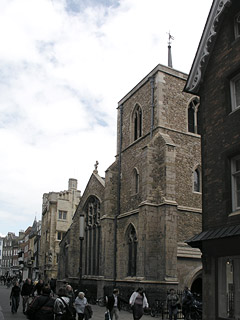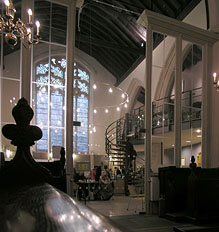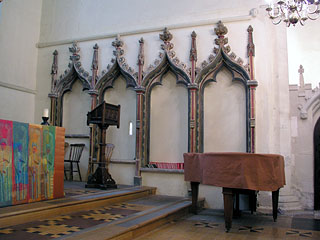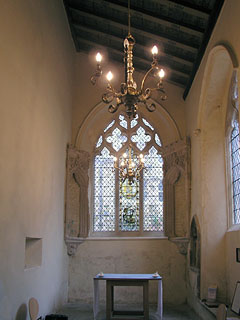 |
What are we to do with our redundant churches? It's a difficult question. Even non-redundant medieval churches can soak up the money of a dwindling congregation, and grand buildings designed for big medieval catholic congregations really aren't very appropriate for the needs of a modern Anglican community. Sometimes the worst happens - go and have a look at Simon Knott's description of Mickfield for a sobering example of how badly things can go wrong. I think that St Michael's (or The Michaehouse Centre as it now likes to be called) is an example of how things might be done differently, though.
Why was St Michael's made redundant in the first place? The problem is, the centre of Cambridge is awash with churches. Walking up Trumpington Street from the Fitzwilliam Museum, and continuing as it becomes into King's Parade and Trinity Street, you pass St Mary the Less on the left, St Botolph on the right, St Bene't just down Benet Street on your right, St Edward down a small alleyway, Great St Mary's resplendent on Senate House Hill, and then St Michael, all within 600 metres of each other. Amazingly, of the six I have just mentioned, it is only St Michael that is not still an active parish church. It was united with the parish of Great St Mary's in 1908, and has been used various ways since.
 |
Not always very kindly, it must be said. When I first arrived in Cambridge in October 2000, St Michael was the site of a perpetual cheap book sale, having been turned (in the 1960s) into the parish hall. I bought quite a few things there, as it happens, but it did seem a terrible shame. There were no visible signs of the liturgical function of the church, and it all seemed shabby and a bit sordid - scuffed floorboards and nasty fluorescent lighting. Except for the occasional pillar, it might as well have been an overgrown garage.
What a joy it was, then, to see what they have done with it since. The nave has been turned into a café and exhibition space, while the chancel and side chapel have been restored and kept as consecrated spaces for worship. A glazed wall separates the two. The adaptation of the nave is competent and understated - it is lit by big chandeliers, and a single mezzanine hangs in the north aisle, reached by a spiral staircase, so that one can sit and munch a flapjack right underneath the arches of the nave arcades. It's all sensitively done, and (unlike the previous travesty) it allows the building to show itself off.
 |
It is a rather fine church. The big east and west window (the nice little tower is on the south side and acts as a porch - rather unusual in Cambridgeshire) have unusual, flowing tracery - the latter is spoilt a little by the bad glass, in my opinion. The chancel arch is huge, and has some remnants of big Morris-esque designs painted on the walls around it. The thing that first struck me about the chancel was how big it is by comparison to the nave - above half again as long, in fact. This is because St Michael's was originally founded in 1324 as a combined parish church and chapel for the college of Michaelhouse (which was later subsumed into Trinity College). The nave was for the parishioners, and the rather better appointed chancel was for the scholars. The collegiate stalls now sitting in the choir aren't originally from here if Pevsner is correct (they are 15th century, but he thinks they came here from Trinity College Chapel). The sedilia and piscina at the east end are particularly nice. The south chapel is named for Hervey de Stanton, Edward II's Chancellor of the Exchequer, founder of the church and of Michaelhouse, who died in 1327.
 |
Will it survive? Time will tell - it seems to do reasonably good business at the moment, though. The puzzle of what to do with such churches is a difficult one, and no options are wholly satisfactory. There's something a bit strange about reading the glossy leaflet advertising the Michaelhouse Centre, with its trendy little picture of the Archangel as its symbol, and its polished business-speak invitations to hire the space for functions. It's a bit distasteful, a bit bland, a bit mealy-mouthed. Preserving churches for the use of congregations of half a dozen every third Sunday in the month, though, seems even worse, though. These churches were once at the centre of their communities - perhaps schemes like this might show us a way to restore them to that position while remaining sensitive to their history and religious role, too. Bravo Michaelhouse, I say - a bold solution to the problem, and I rather like it. And they do make good flapjacks.
[Mark adds: I am in two minds about The Michaelhouse Solution. Somehow it's a bit too chic, a bit too tasteful - I think in a place like Cambridge it would make a better living building used for study. In Siena the vast undercrofts and cloisters of most of the conventual churches have been given to the University and now host student refectories, libraries etc - something similar would work here I think. On the other hand, at least the place is looked after now - though there's a distinct drop in the maintenence level once you're through the huge glass doors into the 'still religious' part of the place. The Stanton Chapel is a delight, and the only part of the building that has an air of peace or sanctity now - strangely it's also the only part from which you cannot see the Beautiful People sipping their Earl Grey...]
The Michaelhouse Centre has a rather swish website that you can go and visit to find out more about the project.
The Michaelhouse Centre is open 9.30am-5.00pm, Monday to Saturday, and at other times for exhibitions and performances. On Sunday it is closed - perhaps due to the Lord's Day Observance Society?
(Apologies to Beyond the Fringe...)